Code First 2
在codefirst一中也說了Mapping是實體與數據庫的紐帶,model通過Mapping映射到數據庫,我們可以從數據庫的角度來分析?首先是映射到數據庫,這個是必須的。數據庫裏面一般包括表、列、約束、主外鍵、級聯操作、實體關系(E-R圖)、存儲過程、視圖、鎖、事務、數據庫結構更新等。在接下來的日子裏,通過數據庫的這些名詞,來學習C#是如何實現或者調用它們來通過代碼操作數據庫。
在code first一中主要是學習了對數據庫的映射,今天主要是學習表的映射。一個model映射一個表,多個modle映射一個表,一個model映射多個表,子類映射表。
一、表名的映射
學習model與表的映射肯定要知道表名的映射,可以通過using System.ComponentModel.DataAnnotations.Schema;命名空間下的[Table("TestStudent")]特性來約定表名的映射。
二、一個model映射一個表
這個就不用多說,一般情況都是一個model映射一個表,在code first一中也有Student類映射到Student表。
三、子類映射表
面向對象的三大特征之一就是繼承,model中也會有繼承實體,那子類如何映射到表中呢?
首先定義了一個Person類,一個繼承Person的Student類。

using System;
using System.Collections.Generic;
using System.ComponentModel.DataAnnotations;
using System.ComponentModel.DataAnnotations.Schema;
using System.Linq;
using System.Text;
using System.Threading.Tasks;
namespace EFCodeFirstModels
{
public enum SexType { Male, Female }
public class Person
{
[Key]
public string PersonId { get; set; }
//姓名
public string Name { get; set; }
//性別
public SexType Sex { get; set; }
//年齡
public int Age { get; set; }
public Person(string personId, string name, SexType sex, int age)
{
PersonId = personId;
Name = name;
Sex = sex;
Age = age;
}
}
}

using System;
using System.Collections.Generic;
using System.ComponentModel.DataAnnotations;
using System.ComponentModel.DataAnnotations.Schema;
using System.Linq;
using System.Text;
using System.Threading.Tasks;
namespace EFCodeFirstModels
{
public class Student : Person
{
public string StuId { get; set; }
public string Major { get; set; }
public string School { get; set; }
public Student(string stuId, string major, string school, string personId, string name, SexType sex, int age) : base(personId, name, sex, age)
{
this.StuId = stuId;
this.Major = major;
this.School = major;
this.PersonId = personId;
this.Name = name;
this.Sex = sex;
this.Age = age;
}
}
}
數據庫上下文還是一默認的

using System;
using System.Collections.Generic;
using System.Linq;
using System.Text;
using System.Threading.Tasks;
using System.Data.Entity;
using EFCodeFirstModels;
using System.Configuration;
namespace EFCodeFirstDataAccess
{
public class EFCodeFirstDbContext:DbContext
{
public EFCodeFirstDbContext() : base("MyStrConn")
{
}
public DbSet<Person> Persons { get; set; }
}
}

在Main中增加一個Person對象,一個Student對象。

using System;
using System.Collections.Generic;
using System.Linq;
using System.Text;
using System.Threading.Tasks;
using EFCodeFirstModels;
using EFCodeFirstDataAccess;
namespace EFCodeFirstDemo
{
class Program
{
static void Main(string[] args)
{
//using能及時釋放資源,例如數據庫連接異常,可以即使將上下文釋放
using (var db=new EFCodeFirstDbContext())
{
Person person = new Person("1001", "張三", SexType.Female, 26);
db.Persons.Add(person);
Student stu = new Student("001", "軟件工程", "藍翔", "1000", "CYW", SexType.Female, 25);
db.Persons.Add(stu);
db.SaveChanges();
Console.WriteLine("Success");
}
Console.ReadLine();
}
}
}

運行之後可以看到數據庫生成了一個People表,多了一列:Discriminator,用來區別子類和父類對象

如果你想改名Discriminator列名,可以使用Fluent API來設置,需要在數據庫上下文中重寫OnModelCreating()方法。

public class EFCodeFirstDbContext:DbContext
{
public EFCodeFirstDbContext() : base("MyStrConn")
{
}
public DbSet<Person> Persons { get; set; }
protected override void OnModelCreating(DbModelBuilder modelBuilder)
{
modelBuilder.Entity<Person>().Map(m =>
{
m.ToTable("Person");
m.Requires("PersonType").HasValue("Person");
}).Map<Student>(m =>
{
m.Requires("PersonType").HasValue("Student");
});
}
}


如果Person只有一個派生類,那我們可以使用布爾值來區別

modelBuilder.Entity<Person>().Map(m =>
{
m.ToTable("Person");
m.Requires("IsStudent").HasValue(false);
}).Map<Student>(m =>
{
m.Requires("IsStudent").HasValue(true);
});

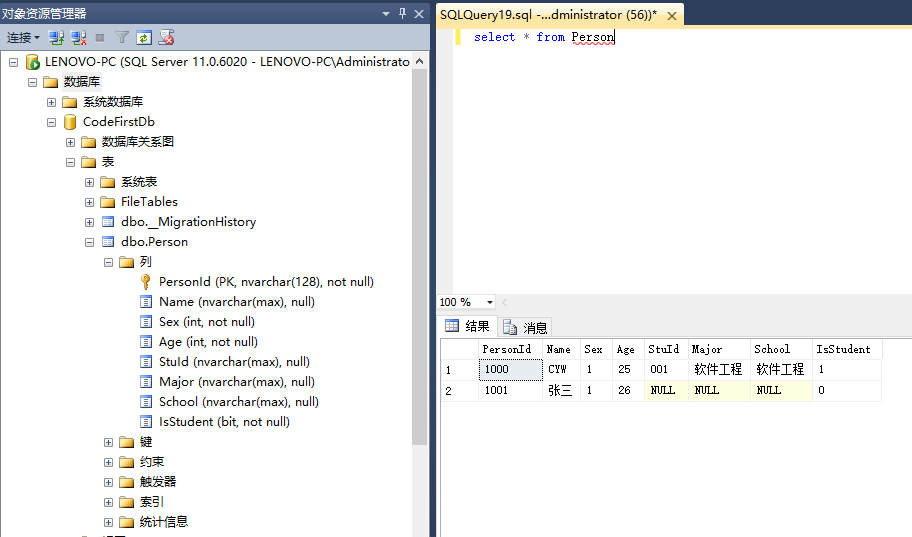
上面是兩個Model生成一個表,基類和派生類都映射到同一張表中,通過使用鑒別列來識別是否為子類型。這是Code First默認規則使用的表映射方法TPH(Table Per Hierarchy)。其實還有兩種映射方法。一種是TPT,一種是TPC.
TPT:Table Per Type,TPH將所有層次的類都放在了一個表裏,而TPT在一個單獨的表中儲存來自基類的屬性,在派生類定義的附加屬性儲存在另一個表裏,並使用外鍵與主表相連接。這種方式只需指定子類表名。
[Table("Student")]
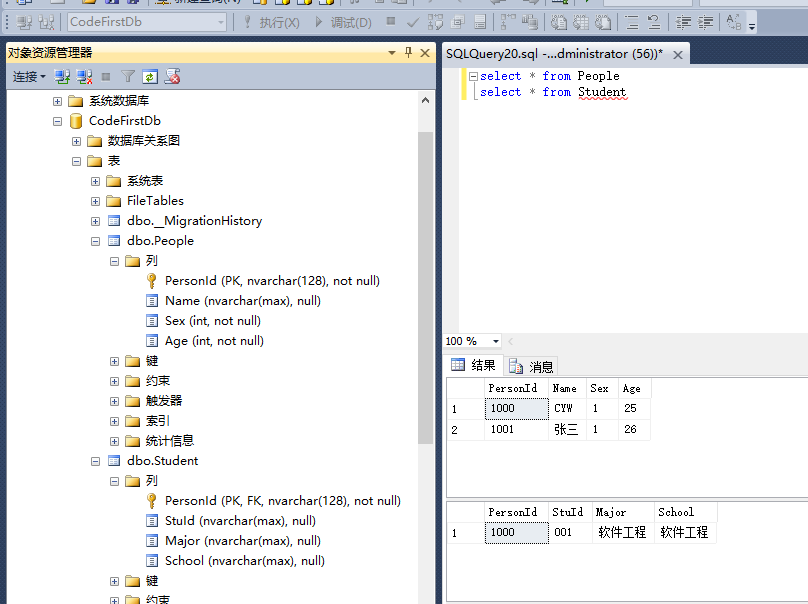
TPC:Table Per Concrete Type,基類與派生類都映射在不同的表中,不同的是派生類中還包括了基類的字段。TPC只能用Fluent API來配置

modelBuilder.Entity<Person>().Map(m =>
{
m.ToTable("Person");
}).Map<Student>(m =>
{
m.ToTable("Student");
m.MapInheritedProperties();
});


四、多個Model映射一個表
上面雖然是兩個類Person、Student映射到一個表中,但主鍵都在基類上定義的,映射一個表還比較容易。如果是兩個沒有繼承關系的Model如何映射到同一張表呢?這個我們在上面Person類Student類的基礎上增加了一個IDCard類,主要是表示身份證類。假設Person的PersonId就是IDCard的PersonId。兩個Model映射一個表,那兩個Molde肯定是一對一的關系,映射的表名相同,主鍵名和類型也要相同,這些是必須的。同時還要指明兩個類的外鍵,只指明一個都不行。

using System;
using System.Collections.Generic;
using System.Linq;
using System.Text;
using System.Threading.Tasks;
using System.ComponentModel.DataAnnotations;
using System.ComponentModel.DataAnnotations.Schema;
namespace EFCodeFirstModels
{
[Table("Person")]
public class IDCard
{
//身份證號
[Key,ForeignKey("People")]
public string PersonId { get; set; }
//法定出生日期
public DateTime BirthDate { get; set; }
public Person People { get; set; }
public IDCard(string personId, DateTime birstDate)
{
PersonId = personId;
BirthDate = birstDate;
}
}
}


using System;
using System.Collections.Generic;
using System.ComponentModel.DataAnnotations;
using System.ComponentModel.DataAnnotations.Schema;
using System.Linq;
using System.Text;
using System.Threading.Tasks;
namespace EFCodeFirstModels
{
public enum SexType { Male, Female }
[Table("Person")]
public class Person
{
[Key, ForeignKey("Card")]
public string PersonId { get; set; }
//姓名
public string Name { get; set; }
//性別
public SexType Sex { get; set; }
//年齡
public int Age { get; set; }
public IDCard Card { get; set; }
public Person(string personId, string name, SexType sex, int age, IDCard card)
{
PersonId = personId;
Name = name;
Sex = sex;
Age = age;
Card = card;
}
}
}


using System;
using System.Collections.Generic;
using System.ComponentModel.DataAnnotations;
using System.ComponentModel.DataAnnotations.Schema;
using System.Linq;
using System.Text;
using System.Threading.Tasks;
namespace EFCodeFirstModels
{
public class Student : Person
{
public string StuId { get; set; }
public string Major { get; set; }
public string School { get; set; }
public Student(string stuId, string major, string school, string personId, string name, SexType sex, int age, IDCard card) : base(personId, name, sex, age, card)
{
this.StuId = stuId;
this.Major = major;
this.School = major;
this.PersonId = personId;
this.Name = name;
this.Sex = sex;
this.Age = age;
this.Card = card;
}
}
}

在Mian中先添加一個Person來看下運行結果。

//using能及時釋放資源,例如數據庫連接異常,可以即使將上下文釋放
using (var db=new EFCodeFirstDbContext())
{
IDCard card = new IDCard("1000", DateTime.Now);
Person person = new Person("1001", "張三", SexType.Female, 26, card);
db.Persons.Add(person);
db.SaveChanges();
Console.WriteLine("Success");
}
Console.ReadLine();
}

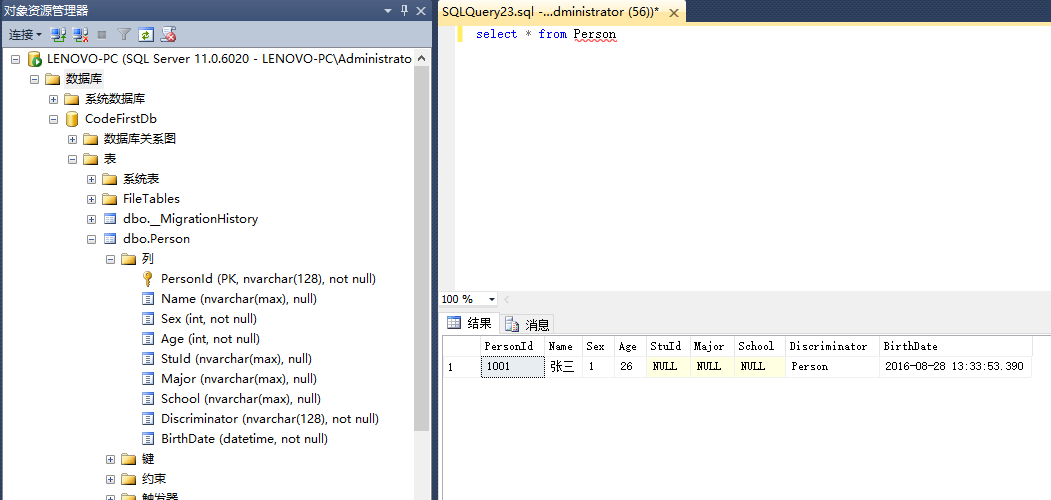
從上面的截圖看到Person表中也有Student的屬性,感覺真是不可思議,amazing.
我們添加一個Person一個Student來看下效果

static void Main(string[] args)
{
//using能及時釋放資源,例如數據庫連接異常,可以即使將上下文釋放
using (var db=new EFCodeFirstDbContext())
{
IDCard card = new IDCard("1000", DateTime.Now);
Person person = new Person("1001", "張三", SexType.Female, 26, card);
db.Persons.Add(person);
IDCard card2 = new IDCard("1000", DateTime.Now);
Student stu = new Student("001", "挖掘機", "藍翔", "1000", "趙鐵蛋", SexType.Male, 25, card2);
db.Persons.Add(stu);
db.SaveChanges();
Console.WriteLine("Success");
}
Console.ReadLine();
}

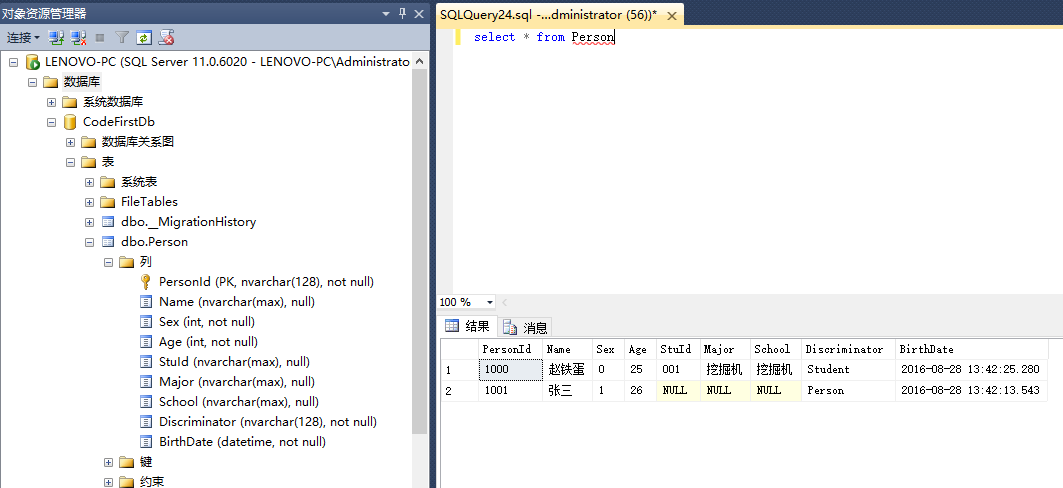
IDCard和Person生成了同一表,我們可以像上面的Fluent API來改變Discriminator列名。也可以使用TPT的方式生成兩個表,只需在Student類上指明映射的表名。
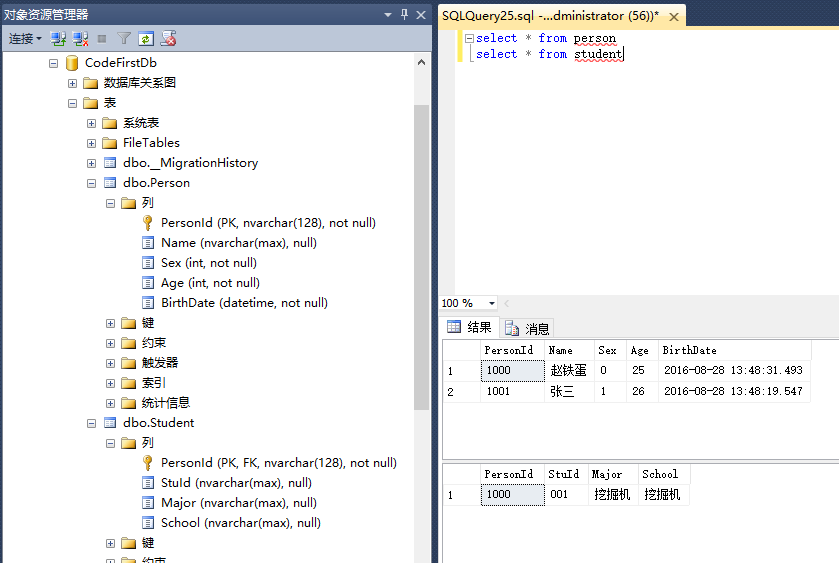
但是TPC就不行了。就會報錯,這可能也是只新增Person的時候Student中的屬性也會自動添加上的原因吧。
五、一個Model映射多個表
一個Model映射多個表和上面多個Model映射一個表正好反過來,還用上面Student和Person舉例。

modelBuilder.Entity<Student>().Map(m=> {
m.ToTable("Person");
m.Properties(p => p.PersonId);
m.Properties(p=>p.Name);
m.Properties(p=>p.Age);
m.Properties(p => p.Sex);
}).Map(m=> {
m.ToTable("Student");
m.Properties(p => p.PersonId);
m.Properties(p=>p.StuId);
m.Properties(p => p.Major);
m.Properties(p => p.School);
});

上面將一個Student類映射給兩個表一個Student一個person.

//using能及時釋放資源,例如數據庫連接異常,可以即使將上下文釋放
using (var db=new EFCodeFirstDbContext())
{
Person person = new Person("1001", "張三", SexType.Female, 26);
db.Persons.Add(person);
Student stu = new Student("001", "挖掘機", "藍翔", "1000", "趙鐵蛋", SexType.Male, 25);
db.Persons.Add(stu);
db.SaveChanges();
Console.WriteLine("Success");
}

Code First 2
